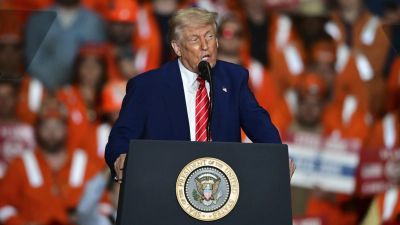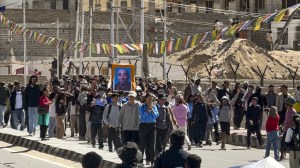Blood spills into Bethlehem churches
The people of one of the Holy Land’s holiest places woke up to the fog and fury of war. In the hours before dawn, the clouded skies of ...

The people of one of the Holy Land’s holiest places woke up to the fog and fury of war. In the hours before dawn, the clouded skies of Bethlehem came alive: an Israeli reconnaissance plane, swooping F-16 fighter jets, Apache attack helicopters with machine guns chattering.
Morning brought rain and tanks, cold winds and armoured personnel carriers that rumbled over muddy hills into the ancient city. The shooting crescendoed as Palestinian gunmen and Israeli soldiers fought battles in a warren of cobblestoned lanes around Manger Square, the site that Christians believe was the birthplace of Jesus.
For the first time in 18 months of struggle between Israelis and Palestinians, combat raged in the very heart of Bethlehem, a crossroads of Muslim, Catholic, Orthodox and Jewish faiths. The bloodshed spilled into the sanctuaries: dozens of Palestinian gunmen holed up in the 4th century Church of the Nativity, one of the oldest churches in the world, and other houses of worship.
The soundtrack was an unseasonable but appropriately violent thunderstorm that, along with the shooting, continued into the night. ‘‘The war and the weather’’, muttered Maher, one of the few Palestinians in the outlying neighbourhood of Beit Jala to venture into the streets. He peered into the mist through the windshield of his ageing sedan as gunfire rattled in the hillsides. Fog obscured the battlefield and, as often happens in this part of the world, the facts.
The Israeli Defence Force said 10 Palestinian gunmen, barricaded inside Santa Maria Church in central Bethlehem, were holding a priest and nuns hostage and firing on troops outside. Palestinians, however, said the clerics, a mix of Palestinians, Europeans and other nationalities, stayed in the church voluntarily to protect the fighters.
Similarly, the Governor of Bethlehem disputed reports that Palestinian Authority fighters, mostly uniformed members of President Yasser Arafat’s security forces, shot their way into the Church of the Nativity. He insisted that the fighters, dragging their wounded with them, took refuge there when they ran out of ammunition.
‘‘The nuns have been giving first aid to the injured,’’ Mohammed Madani, the Palestinian Governor, said in a telephone interview from an undisclosed location where he was lying low. ‘‘The priests are giving them food.’’
The Israeli army was negotiating with the gunmen to give themselves up, the same sources said. ‘‘We have tried to establish contact with them so that they can be arrested without spilling blood,’’ a military source said. Palestinian civilians inside the church told AFP by telephone there were around 300 people there, mostly women, children and civilian men. Earlier reports had put the number at 150.
A man who said he was the commander of the gunmen inside the church, who refused to give his name or specify whether he was a policeman or a member of an armed faction, said his men were under orders not to open fire.
Bethlehem Mayor Hana Nasser said soldiers had occupied the municipality building overlooking the square and the church. Israeli forces pushed into other West bank centers before dawn on Wednesday, entering the northern towns of Salfit and Jenin and the Jelazoun refugee camp in search for suspected militants and weapons, the Army said.
As Israeli soldiers encircled the church, the Palestinians rested in pews and on the stone floor, said a Palestinian policeman inside the church. Arafat also criticised Bethlehem incursion: ‘‘Today they attacked Bethlehem where Jesus was born. Can you imagine? They are striking the Church of the Virgin Mary.’’
The head of the Roman Catholic Church in Jerusalem on Wednesday offered sanctuary to Palestinian militants holed up in the Bethlehem church marking Christ’s birthplace, saying they had thrown down their arms.
‘‘The Basilica, a church is a place of refuge for everybody, even fighters, as long as they lay down their arms,’’ Michel Sabbah said.
The Israeli Army said one soldier was wounded by Palestinian gunfire in the Jenin area and had been evacuated. ‘‘We hear a lot of shooting. There are Apache helicopters overhead, tanks in the middle of town, and quite a bit of firing,’’ Ali Jarbawi, a university professor, said by telephone.





- 01
- 02
- 03
- 04
- 05


























